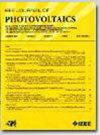Measurement and Simulation of Moisture Ingress in PV Modules in Various Climates
IF 2.6
3区 工程技术
Q3 ENERGY & FUELS
引用次数: 0
Abstract
Moisture plays a critical role in the degradation process of photovoltaic (PV) modules in field conditions. A commonly used approach is to evaluate the properties of PV materials by conducting tests in climatic chambers, and then apply the Fickian diffusion model in simulations to replicate field conditions, however, without experimental verification. This study describes an experimental setup for in situ measurement of moisture in fielded minimodules, using miniature temperature and humidity sensors encapsulated within the modules. Five identical setups are deployed in different climatic regions around the world, enabling a quantitative evaluation of moisture diffusion in the field and a comparison of different climates. The relative humidity measured beside the cell follow weekly weather trends due to breathable backsheet, whereas the sensors in front of the cell react much slower to outside changes and follow seasonal trends. We show that a single 2-D simulation, which is a standard practice in published studies, is insufficient to accurately depict moisture diffusion in front of the cell. Therefore, a two-stage 2-D simulation model, combining Fickian diffusion in vertical and horizontal cross section with carefully set boundary conditions, was introduced. A comparison with measurement results showed the simulation approach to be a good compromise between the simulation accuracy and speed. Finally, the results underscore the significance of understanding the local microclimate surrounding the modules, including the interface between air and backsheet, which is necessary for precise moisture diffusion simulations.测量和模拟各种气候条件下光伏组件中的湿气侵入情况
湿气在光伏(PV)组件在现场条件下的降解过程中起着至关重要的作用。常用的方法是通过在气候箱中进行测试来评估光伏材料的特性,然后在模拟中应用菲克扩散模型来复制现场条件,但这种方法没有经过实验验证。本研究介绍了使用封装在组件中的微型温度和湿度传感器对现场微型组件中的湿度进行现场测量的实验装置。在全球不同的气候区部署了五个相同的装置,以便对现场湿度扩散情况进行定量评估,并对不同气候进行比较。由于背板具有透气性,在电池旁边测量到的相对湿度会跟随每周的天气变化趋势,而电池前面的传感器对外界变化的反应要慢得多,并且会跟随季节变化趋势。我们的研究表明,单一的二维模拟(这是已发表研究的标准做法)不足以准确描述电池前面的湿气扩散情况。因此,我们引入了一个两阶段的二维模拟模型,该模型结合了垂直和水平横截面上的菲克扩散和精心设置的边界条件。与测量结果的对比显示,该模拟方法在模拟精度和速度之间取得了良好的平衡。最后,研究结果强调了了解组件周围局部小气候(包括空气与背板之间的界面)的重要性,这对于精确的湿气扩散模拟十分必要。
本文章由计算机程序翻译,如有差异,请以英文原文为准。
求助全文
约1分钟内获得全文
求助全文
来源期刊

IEEE Journal of Photovoltaics
ENERGY & FUELS-MATERIALS SCIENCE, MULTIDISCIPLINARY
CiteScore
7.00
自引率
10.00%
发文量
206
期刊介绍:
The IEEE Journal of Photovoltaics is a peer-reviewed, archival publication reporting original and significant research results that advance the field of photovoltaics (PV). The PV field is diverse in its science base ranging from semiconductor and PV device physics to optics and the materials sciences. The journal publishes articles that connect this science base to PV science and technology. The intent is to publish original research results that are of primary interest to the photovoltaic specialist. The scope of the IEEE J. Photovoltaics incorporates: fundamentals and new concepts of PV conversion, including those based on nanostructured materials, low-dimensional physics, multiple charge generation, up/down converters, thermophotovoltaics, hot-carrier effects, plasmonics, metamorphic materials, luminescent concentrators, and rectennas; Si-based PV, including new cell designs, crystalline and non-crystalline Si, passivation, characterization and Si crystal growth; polycrystalline, amorphous and crystalline thin-film solar cell materials, including PV structures and solar cells based on II-VI, chalcopyrite, Si and other thin film absorbers; III-V PV materials, heterostructures, multijunction devices and concentrator PV; optics for light trapping, reflection control and concentration; organic PV including polymer, hybrid and dye sensitized solar cells; space PV including cell materials and PV devices, defects and reliability, environmental effects and protective materials; PV modeling and characterization methods; and other aspects of PV, including modules, power conditioning, inverters, balance-of-systems components, monitoring, analyses and simulations, and supporting PV module standards and measurements. Tutorial and review papers on these subjects are also published and occasionally special issues are published to treat particular areas in more depth and breadth.
 求助内容:
求助内容: 应助结果提醒方式:
应助结果提醒方式:


